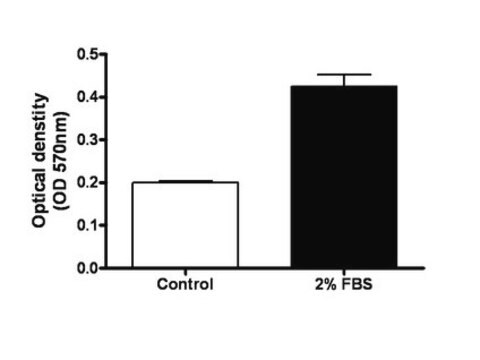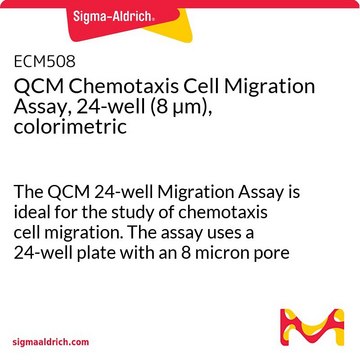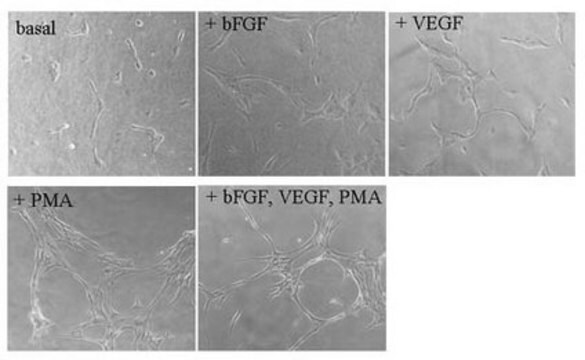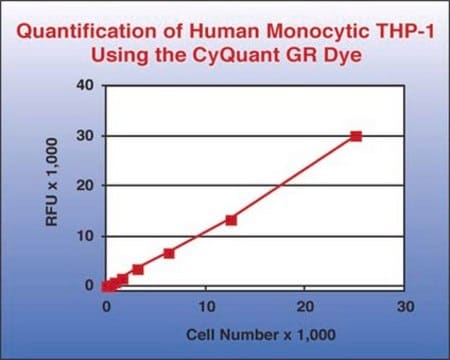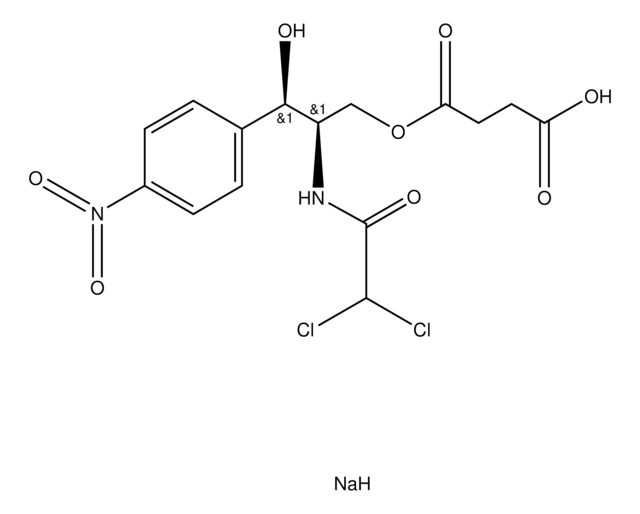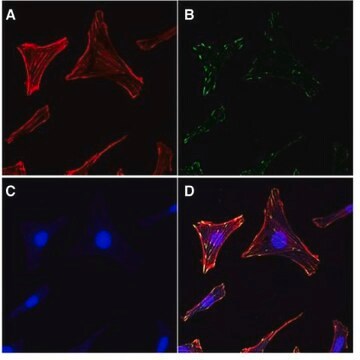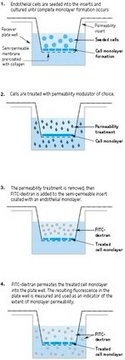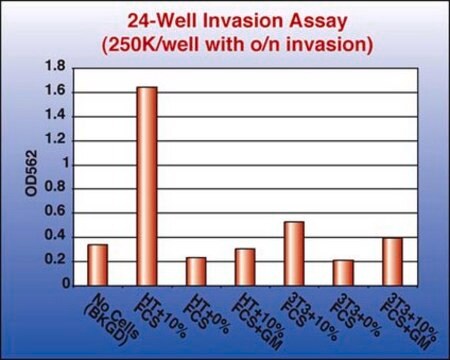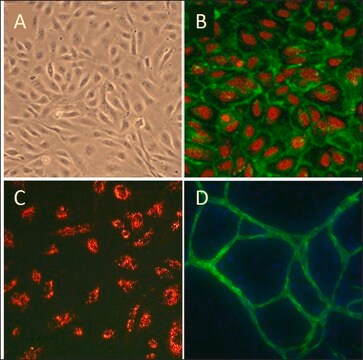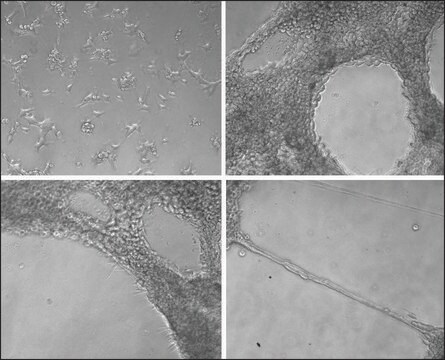ECM200
QCM 3 µm Endothelial Cell Migration Assay Fibronectin, Colorimetric
Synonyme(s) :
Endothelial migration assay
Se connecterpour consulter vos tarifs contractuels et ceux de votre entreprise/organisme
About This Item
Code UNSPSC :
12352207
eCl@ss :
32161000
Nomenclature NACRES :
NA.84
Produits recommandés
Fabricant/nom de marque
Chemicon®
QCM
Niveau de qualité
Technique(s)
cell based assay: suitable
Méthode de détection
colorimetric
fluorometric
Conditions d'expédition
wet ice
Description générale
Also available: Cell Comb Scratch Assay! Get biochemical data from a scratch assay!Click Here
Introduction
Angiogenesis is a fundamental process involving the growth of new blood vessels from pre-existing vessels. It is important in development and wound healing, as well as pathologic diseases such as diabetic retinopathy and cancer. During angiogenesis, endothelial cells need to move out of existing vessels, migrate into new areas, proliferate and assemble into new capillaries. The migration of endothelial cells is regulated by many angiogenic factors and anti-angiogenic factors. It is critical for researchers to understand the mechanisms of endothelial cell migration.
Millipore′s 3 μm QCM Endothelial Cell Migration Assay – Fibronectin, Colorimetric provides a quick and efficient system to study the ability of compounds to induce or inhibit endothelial cell migration. This assay also allows screening of pharmacological agents, evaluation of integrins or other adhesion receptors responsible for endothelial cell migration, analysis of gene function in transfected cells, and determination of ECM protein involvement in cell movement.
This versatile assay permits counting of individual migratory cells, and, more importantly, allows quantitative analysis by optical density (OD) using a standard microplate reader. This convenient assay allows large scale screening and quantitative comparison of multiple samples and includes individual migration controls for each sample.
Introduction
Angiogenesis is a fundamental process involving the growth of new blood vessels from pre-existing vessels. It is important in development and wound healing, as well as pathologic diseases such as diabetic retinopathy and cancer. During angiogenesis, endothelial cells need to move out of existing vessels, migrate into new areas, proliferate and assemble into new capillaries. The migration of endothelial cells is regulated by many angiogenic factors and anti-angiogenic factors. It is critical for researchers to understand the mechanisms of endothelial cell migration.
Millipore′s 3 μm QCM Endothelial Cell Migration Assay – Fibronectin, Colorimetric provides a quick and efficient system to study the ability of compounds to induce or inhibit endothelial cell migration. This assay also allows screening of pharmacological agents, evaluation of integrins or other adhesion receptors responsible for endothelial cell migration, analysis of gene function in transfected cells, and determination of ECM protein involvement in cell movement.
This versatile assay permits counting of individual migratory cells, and, more importantly, allows quantitative analysis by optical density (OD) using a standard microplate reader. This convenient assay allows large scale screening and quantitative comparison of multiple samples and includes individual migration controls for each sample.
Application
The Millipore QCM 3 μm Endothelial Cell Migration Assay – Fibronectin, Colorimetric is ideal for the study of endothelial cell migration in response to an angiogenic stimulus. The quantitative nature of this assay is especially useful for large scale screening of pharmacologic agents. BSA-coated control chambers provide an appropriate migration control. The 3 μm pore size in this assay is optimal for endothelial cells such as HUVEC, but not sufficient for fibroblast migration. The Millipore QCM 3 μm Endothelial Cell Migration Assay – Fibronectin, Colorimetric assay is intended for research use only; not for diagnostic applications.
Each kit provides sufficient materials for the evaluation of 12 samples.
Each kit provides sufficient materials for the evaluation of 12 samples.
Conditionnement
Sufficient for 12 assays
Composants
1. Fibronectin Test Plate: One 24-well culture plate, containing 12 human FN-coated Boyden chambers, sufficient for the evaluation of 12 test samples.
2. BSA Control Plate: One 24-well culture plate, containing 12 BSA-coated Boyden chambers, sufficient for the evaluation of 12 controls.
3. Cell Stain Solution: One vial - 10 mL
4. Extraction Buffer: One vial - 10 mL
5. 24-Well Stain Extraction Plate
6. 96-Well Stain Quantitation Plate
7. Swabs: 50 ea
8. Forceps: 1 pair
2. BSA Control Plate: One 24-well culture plate, containing 12 BSA-coated Boyden chambers, sufficient for the evaluation of 12 controls.
3. Cell Stain Solution: One vial - 10 mL
4. Extraction Buffer: One vial - 10 mL
5. 24-Well Stain Extraction Plate
6. 96-Well Stain Quantitation Plate
7. Swabs: 50 ea
8. Forceps: 1 pair
Stockage et stabilité
Store kit materials at 2° to 8°C for up to their expiration date. Do not freeze.
Informations légales
Accutase is a registered trademark of Innovative Cell Technologies, Inc.
CHEMICON is a registered trademark of Merck KGaA, Darmstadt, Germany
Clause de non-responsabilité
Unless otherwise stated in our catalog or other company documentation accompanying the product(s), our products are intended for research use only and are not to be used for any other purpose, which includes but is not limited to, unauthorized commercial uses, in vitro diagnostic uses, ex vivo or in vivo therapeutic uses or any type of consumption or application to humans or animals.
Mention d'avertissement
Danger
Mentions de danger
Conseils de prudence
Classification des risques
Eye Irrit. 2 - Flam. Liq. 2
Code de la classe de stockage
3 - Flammable liquids
Classe de danger pour l'eau (WGK)
WGK 3
Certificats d'analyse (COA)
Recherchez un Certificats d'analyse (COA) en saisissant le numéro de lot du produit. Les numéros de lot figurent sur l'étiquette du produit après les mots "Lot" ou "Batch".
Déjà en possession de ce produit ?
Retrouvez la documentation relative aux produits que vous avez récemment achetés dans la Bibliothèque de documents.
Les clients ont également consulté
Positive influence of AP-2alpha transcription factor on cadherin gene expression and differentiation of the ocular surface.
Judith A West-Mays, Jeremy M Sivak, Steve S Papagiotas, Jennifer Kim, Timothy Nottoli et al.
Differentiation null
Bingchen Han et al.
Molecular therapy : the journal of the American Society of Gene Therapy, 30(2), 672-687 (2021-07-19)
Triple-negative breast cancer (TNBC) has a high propensity for organ-specific metastasis. However, the underlying mechanisms are not well understood. Here we show that the primary TNBC tumor-derived C-X-C motif chemokines 1/2/8 (CXCL1/2/8) stimulate lung-resident fibroblasts to produce the C-C motif
Maximilian Seles et al.
Cancers, 12(5) (2020-05-14)
POU3F3 adjacent non-coding transcript 1 (PANTR1) is an oncogenic long non-coding RNA with significant influence on numerous cellular features in different types of cancer. No characterization of its role in renal cell carcinoma (RCC) is yet available. In this study
Notre équipe de scientifiques dispose d'une expérience dans tous les secteurs de la recherche, notamment en sciences de la vie, science des matériaux, synthèse chimique, chromatographie, analyse et dans de nombreux autres domaines..
Contacter notre Service technique